Geomorphology is the study of the nature and origin of landforms, particularly of the formative processes of weathering and erosion that occur in the atmosphere and hydrosphere. These processes continually shape the Earth's surface, and generate the sediments that circulate in the Rock Cycle. Landforms are the result of the interactions among the geosphere, atmosphere and hydrosphere.
Weathering
Weathering is the alteration and breakdown of rock minerals and rock masses when they are exposed to the atmosphere. Weathering processes occur in situ, that is, in the same place, with no major movement of rock materials involved.
Weathering is a fundamental Earth process. Weathering changes rocks from a hard state, to become much softer and weaker, making them more easily eroded.
Weathering Processes
Two main groups of weathering processes are identified, with a third supporting group:
- Physical weathering: the group of processes, such as frost wedging and volume changes of minerals, that result in the mechanical disruption of rocks (e.g. granular disintegration, exfoliation, joint block separation, shattering by changes in temperature or pressure).
- Chemical weathering: the decay of rock forming minerals caused by water, temperature, oxygen, hydrogen and mild acids (e.g. solution, hydration, oxidation, carbonation).
- Biological weathering: the group of processes that are caused by, or assisted by, the presence of vegetation, or to a lesser extent animals, including root wedging and the production of organic acids.
The type of weathering processes that occur at any particular location depend predominantly upon the climate:
- Physical weathering: mechanical processes dominate in cold and dry climates.
- Chemical weathering: processes of mineral decay dominate in warm and humid climates.
- Biological weathering: vegetation, and animals, tend to be more active in warm and humid climates.
Weathering Controls
The type, rate and extent of weathering depends upon several controlling factors:
- Climate dictates the type of weathering processes that operate, largely by determining the amount of water available and the temperature at which the processes occur. Chemical reactions are faster at higher temperatures, while frost wedging occurs in colder climates.
- Rock Type determines the resistance of the rock to the weathering processes that operate in that particular environment. Each rock type is composed of a particular set of minerals, which are joined together by crystallisation, chemical bonding or cementing. When the forces of plate tectonics move these rocks from the environment in which they formed and expose them to the atmosphere they begin to weather.
- Rock Structure: highly jointed or faulted rocks present many planes of weakness along which weathering agents (e.g. water) can penetrate into the rock mass (Figures 1 & 2).
- Topography: the slope angle determines the energy of the weathering system by controlling the rate at which water passes through the rock mass. Generally, higher, or tectonically active areas with steeper slopes have more dynamic weathering systems, whereas flat plains have slower weathering systems.
- Erosion: the dynamism and efficiency of erosion determines how rapidly any weathered material is removed, how frequently fresh rock is exposed to weathering, and if deeply weathered profiles are preserved.
- Time: the duration of the period that the same type of weathering has been operating, uninterrupted by climatic change, earth movements, and other factors, determines the degree and depth to which the rocks have been weathered.
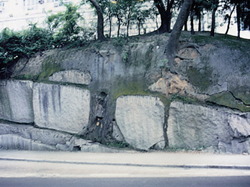
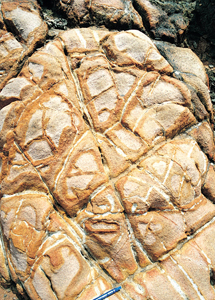
Weathering Products
Weathering gradually weakens rocks, and eventually produces new geological materials (rock fragments, sands, silts and clays) that are more stable in the new environment. Weathering generally produces finer and less dense rock materials, and weaker, more porous and permeable rock masses.
In the tropics and subtropics, intense weathering in the hot and humid conditions produces thick weathered profiles, which may be up to 100 metres, or more, thick.
Weathering processes penetrate down discontinuities (planes of weakness), such as faults and joints, in the rock mass and then attack the faces of the joint-bounded blocks, penetrating the solid blocks (Figure 3).
Weathering preferentially attacks the corners and edges of the joint blocks, causing them to become rounded. This action is assisted by stress release, which causes the rock to flake into curved shells in a process termed exfoliation (Figure 4).
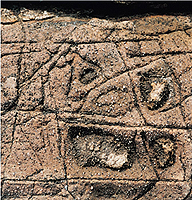
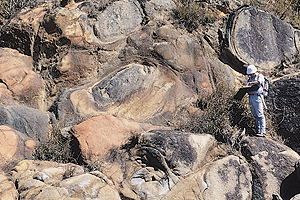
Weathering of some rock types, such as the granitic rocks and the coarse ash tuffs, results in the development of thick weathered profiles that are characterised by rounded boulders (corestones) set in a matrix of weak, silty, clayey, sandy material. These corestone-bearing profiles are a distinctive feature of many cut-slopes in the urban areas of Hong Kong Island and Kowloon (Figure 5).
The downward limit of weathering may be irregular and diffuse, but in many cases terminates abruptly at a well-defined horizon (Figure 6). This boundary is termed the weathering front by geomorphologists, or rockhead by engineers (Figure 7).
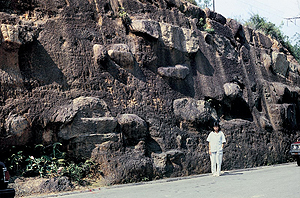
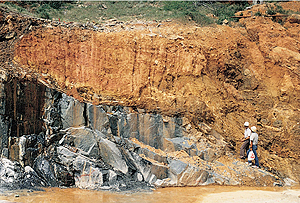
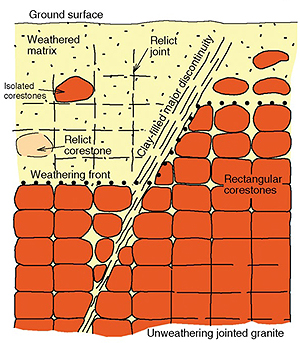
Erosion
Erosion is the removal (transport) of weathered rock materials downslope, and away, from their original site of weathering. Erosion processes are driven primarily by the force of gravity, which may be aided by a flowing medium such as water (e.g. rivers), and ice (e.g. glaciers), or gravity may act alone (e.g. rockfalls). Wind can also remove weathered materials (e.g. deflation).
During transportation of the weathered rock materials, the angular particles commonly abrade (rub or scour) the surfaces over which they pass, wearing away and lowering the rocks. Thus, landslide debris may erode the slope or channel along its course, the sediments in rivers erode the rocky sections of their beds, and the rock fragments in glaciers erode the valley floor.
Erosion Processes
Erosion processes are usually considered under four distinct categories:
- Mass Wasting: the processes that occur on slopes, under the influence of gravity, in which water may play a part, although water is not the main transporting medium. Mass wasting, or landsliding (see below), processes are very important in Hong Kong (Figure 8).
- Fluvial: the processes that involve flowing water, which can occur within the soil mass (e.g. soil piping), over the land surface (e.g. rills and gullies (Figure 9)), or in seasonal or permanent channels (e.g. seasonal streams and rivers). Fluvial processes are very important in Hong Kong.
- Wind: the processes that involve the action of rapidly moving air streams in dry areas, which can be cold or hot deserts. The erosional effects of wind play only a small role in Hong Kong.
- Glacial: the processes that involve the presence of ice, either in the soil (e.g. solifluction), or as the transporting medium (e.g. glaciers). Glacial processes do not directly affect Hong Kong.
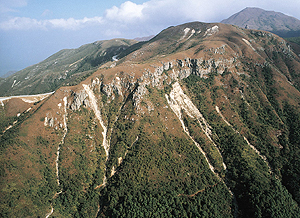

Erosion Controls
The type and magnitude of erosion depends upon several factors including:
- Climate: exerts a fundamental control on the types and rates of erosion in an area, because climate determines the amount and seasonal distribution of water (rainfall), the temperature (tropical, temperate or polar), and factors such as the sunshine hours, the wind strengths, and wind patterns.
- Topography: mountain areas have a higher elevation and thus greater potential energy than the lowlands. This, combined with the steeper slope angles, results in more dynamic erosion in upland areas than on the surrounding plains.
- Rock Type: the type of rock determines how susceptible an area is to erosion. Within the same climatic regime, each rock type responds differently to weathering and erosion, exhibiting a characteristic resistance or weakness to the prevailing conditions. Thus, some rocks are relatively resistant and form higher ground, whereas others are less-resistant and form valleys and lowlands.
- Rock Structure: highly jointed or faulted rocks are usually more intensely weathered along the lines of weakness in the rock mass. Consequently, these softer weathered materials are more easily eroded out, with the result that river valleys are usually located along the line of a major fault or joint set.
Erosion Products
The rock and soil materials transported by erosion processes are eventually deposited in the sea, although they may be temporarily deposited in other locations such as below cliff faces (e.g. as screes), on hillsides (e.g. as colluvium (Figure 10)) beside rivers (e.g. as flood plains), in lakes (e.g. as deltas), or on desert plains (e.g. sand dunes).
Over the millennia, the topography of an area is sculptured by the processes of erosion, from an original mass of folded or uplifted rocks into a complex of mountain summits, intervening valleys, and surrounding plains.
Gravity causes landslides on hillsides, flowing water erodes gullies and shallow stream courses (Figure 11), and joint-bounded blocks of rock fall from cliff faces building up screes. On lower ground, rivers carve valleys and deposit floodplain sediments. Below the ground surface, in soluble rocks such as limestone, water erodes passages, caves and shafts.
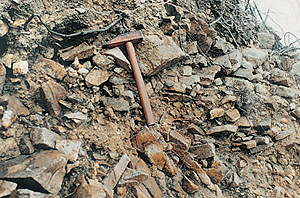

The ultimate result of erosion is to reduce all mountains, ridges, and high ground to a flat plain (termed a peneplain) that slopes very gently from the centre of a landmass to the sea.
Superficial Deposits
When rocks are weathered, they break down into loose rock and mineral grains, which are then carried away by erosion processes. These sediments are transported by water, wind, or gravity, and are eventually deposited in various sedimentary environments. Superficial deposits are unconsolidated accumulations of sediments on the landscape.
Classification of Superficial Deposits
Superficial deposits are generally classified into three broad categories according to environments of deposition: terrestrial (land), shoreline and marine environments (Figure 12 & Table 1). A sedimentary environment results from the interaction of various factors, including plate tectonic setting, geographical location of the site, transporting agents, organisms that may modify the sediments, and climatic system. The sedimentary environment of a site may change over time in response to factors such as shifting river channels and relative sea level changes.
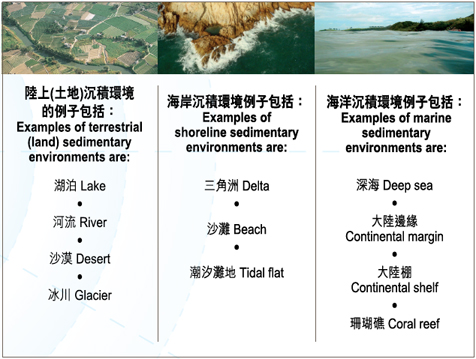
Table 1: Example of various types of depositional environments.
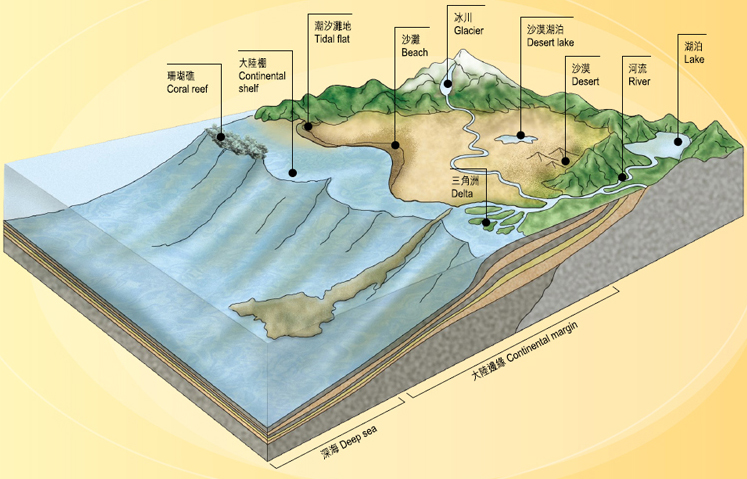
Figure 12: Depositional sedimentary environments.
Landslides
Landsliding, or slope failure, is a general term that encompasses the gravity-controlled, mass wasting processes that affect hillslopes throughout the world.
Natural Slopes
Under normal circumstances, natural slopes (i.e. slopes that are largely unmodified by human activities) reach a state of quasi-equilibrium, in which the slope is eroded to an angle that is relatively stable with regard to the underlying rock type and structure, the soil type and thickness, the extent and type of the vegetation cover, the surface and subsurface hydrology, and the prevailing climatic conditions and local weather patterns.
Weathering processes continually act upon the slopes, weakening the underlying rocks. Groundwater flushes-out some of the weathered materials from the joints in the rocks and from the overlying soils, and hillside streams deepen their channels.
The rocks and soils of the slope progressively become weaker and less stable, so sections of the slope periodically readjust to a more stable profile by failing (landsliding) (Figure 13).
Importantly, if one or other of the factors on the slope changes, such as the tree cover is removed by fire or forestry, or an exceptionally heavy rainfall occurs, then large areas of a hillside may be subject to erosion, including failure (landslide).
In addition, steep stream courses carry considerable amounts of surface runoff during heavy rainstorms. This water, and the included debris, can severely erode the stream channel, destabilising the stream banks and the adjacent slopes, triggering slope failures. In extreme circumstances, earthquakes may shake an area and loosen large masses of material, causing landslides or disturbing the previous equilibrium.
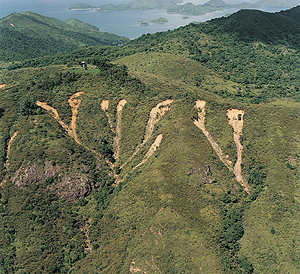
Figure 13: Coalescing channelised debris
avalanches originating from shallow failure scars.
Man-made Slopes
Many of the hillsides adjacent to urban areas in Hong Kong have been modified to create platforms for buildings and benches for roads. This process creates a very steep cutting (a cut slope), which changes the geometry of the original slope, affects the groundwater regime, and may expose unfavourably oriented joint planes or other lines of weakness within the rock (Figure 14).
Man-made slopes are, by their very nature, steeper than most natural slopes. They are not in a natural equilibrium with the profile of the original hillside into which they are excavated. Consequently, some forms of engineering stabilisation works are normally required.

Figure 14: Types of slope.
Engineers plan and design these cut slopes, or man-made slopes, to make them as safe as possible by using techniques such as:
- Slope support : e.g. rock bolting, soil nailing, and retaining walls.
- Surface protection: e.g. stone pitching and shotcreting.
- Slope drainage: e.g. weepholes, raking drains, U-channels, stepped channels.
Failures of man-made slopes primarily occur along joint planes in fresh rock, and in some cases along relict joint planes in weathered rock. These discontinuities, which are commonly clay-filled in Hong Kong, present lines of weakness that allow blocks of material to become detached from the slope when the friction on the plane is overcome, or when the material that originally supported the toe of the slope is removed.
The consequences of failures of man-made slopes are usually more immediately apparent than those on natural terrain, because they directly affect roads and populated areas.
Fluvial Processes
Rivers develop distinctive dendritic systems. Viewed on a map, dendritic systems form a pattern that looks like the trunk and branches of a tree. Small streams on hillsides gradually coalesce downslope to form progressively larger streams until, ultimately, they enter the master stream on the plains below. This master stream, which may receive other tributaries along the way, usually flows all the way to the sea.
The steep gradients of the headwater streams are characterised by their high energy. Consequently, they tend to erode, or downcut, their channels (destructive processes). As the gradient reduces lower down the hillside, the energy of the stream decreases and depositional (constructive) processes assume increasing importance.
The vertical profile of a stream is controlled by the base level, which is usually the same as the sea level. Locally, lakes or reservoirs may act as a temporary base level. As sea level rises or falls, the stream profile will adjust to the new base level, either by eroding (in times of sea level fall), or depositing (in times of sea level rise). Thus, changes in base level will lead to migration of the boundary between destructive and constructive processes along the stream profile.
Fluvial Landforms Associated with Destructive Processes
| Type of Landforms and its Local Example | Description | |
|---|---|---|
| Valley (e.g. the Lam Tsuen Valley) |
A linear topographical depression formed by the erosive action of flowing water and occupied by a stream or river |  |
| Waterfall (e.g. the Bride's Pool waterfall) |
A step in the long profile of a stream, usually associated with a band of hard, resistant rock, over which the river falls. Also known as a knick point | |
Fluvial Landforms Associated with Constructive Processes
| Type of Landforms and its Local Example | Description | |
|---|---|---|
| Meandering Channels (e.g. Kam Tin River) |
On plains, river channels develop sinuous courses, a process that is termed meandering. An individual curve or loop in the channel is a meander. Meandering streams are usually close to base level, have low gradients, low velocities, and generally contain little coarse bedload. | 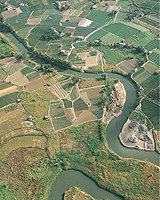 |
| Floodplain (e.g. Yuen Long Plain) |
Meandering streams migrate down gradient by a process of eroding on the outer bank and depositing on the inner bank (the point bar), slowly building up a sheet of sediment that is termed a floodplain. | 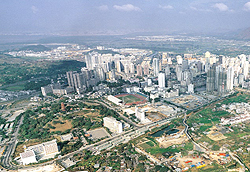 |
| River Terraces (e.g. Lam Tsuen Valley) |
As a river continues to erode its bed, if sea level falls, or if the land level is raised, the river channel will be below the original floodplain. This higher, abandoned floodplain is termed a river terrace. Successive events may create a series of river terraces | |
| Natural Levee (e.g. Kam Tin River) |
An embankment that develops on both sides of a stream or river channel when periodic flooding causes deposition of sandy sediments close to the channel, with silt deposited on the floodplain beyond. Levees form natural flood protection defences as they raise the height of the channel sides. | |
| Swamp | A hollow or shallow depression on a floodplain, which may be an abandoned meander curve, in which the water table is high and drainage is poor, so a wetland is formed in which vegetation thrives. | |
Coastal Processes
The primary geomorphological process along coastlines is wave action. Beaches are subdivided into several zones, which are based on their morphology, and on their position with respect to water levels and wave activity (Figure 15).
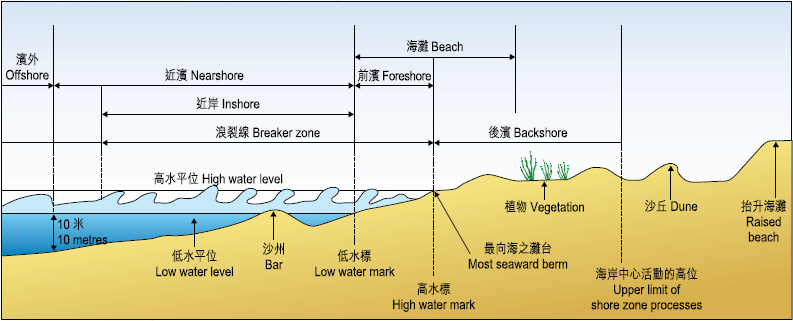
Figure 15: Beach profile terminology.
Waves are generated by winds crossing the sea, so the types and strengths of the waves are dependent upon the orientation of the coastline with respect to the prevailing waves (the exposure), and the distance of uninterrupted sea over which the winds can pass (the fetch).
Waves are broadly classified as destructive or constructive, depending upon whether they cause erosion or deposition.
Destructive waves are usually associated with high-energy conditions and a steeply sloping offshore zone. Rocky shorelines tend to erode when they are exposed to large waves and high tides.
On sandy shorelines, destructive waves result in the lowering (degradation) of a beach because the backwash (seaward flow) of the waves is more effective than the swash (the landward flow), which results in more material moving seawards than landwards.
Constructive waves result in the building up of a beach, because the swash is more effective in moving material than the backwash. Constructive waves are usually associated with low-energy coasts that have a gently sloping offshore zone, experience smaller waves, and have a limited tidal range.
It is important to note that coastal landforms are controlled not only by geomorphological processes, but also by the characteristics of the underlying geology, such as the rock type and geological structures. The geological structures, combined with the different resistance of the rocks to weathering and erosion, lead to irregularities in the coast such as headlands, bays, sea stacks and arches.
Coastal Landforms Resulting from Destructive Processes
| Type of Landforms and its Local Example | Description | |
|---|---|---|
| Headland (e.g. Town Island) |
A rocky promontory along a coastline that is exposed to strong wave action. | 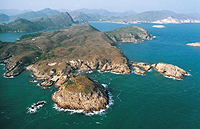 |
| Sea Cave (e.g. Crooked Island) |
A cave is an opening developed in a sea cliff by wave action exploiting joints in the rocks. | 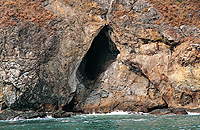 |
| Sea Arch (e.g. Ap Chau) |
A bridge-like feature that results when erosion penetrates a narrow headland or ridge from two directions, most commonly when caves developing from two directions along a line of weakness meet. Arches may be at, or above, sea level. | 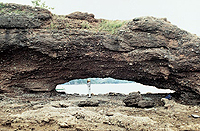 |
| Sea Stack (e.g. Ping Chau) |
A tower, or residual stump, of rock, which is formed by wave action, commonly by the collapse of a sea arch leaving the seaward end isolated. Stacks may be near, or above, the present sea level. | 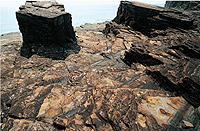 |
| Wave-cut Platform (e.g. Ping Chau) |
A rocky ledge, usually at the base of a sea cliff, that is formed by wave abrasion. Wave-cut platforms may be located above or below high tide level. | 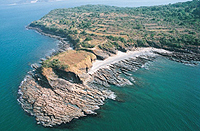 |
| Wave-cut Notch (e.g. Ping Chau) |
A slot cut at the bottom of a cliff, usually at the back of a wave-cut platform, formed by wave action eroding the base of the cliff. |  |
Coastal Landforms Resulting from Constructive Processes
| Type of Landforms and its Local Example | Description | |
|---|---|---|
| Beach (e.g. Tai Long Wan) |
Sediment is derived from the land by weathering and erosion, and is transported to the coast by rivers. The finer sediments are commonly carried out to sea, and the coarser sediments, such as sand, tend to remain near the coast. Constructional waves and currents redistribute the sediment along the coast forming different types of beaches. | |
| Sand Bar (e.g. Double Island) |
A ridge-like accumulation of sediment, usually sand or muddy sand, that forms parallel to the coastline where constructive waves drive sediments up towards the shoreline to form elongate bars that are exposed at low tide. | 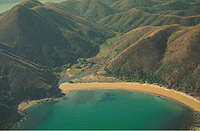 |
| Beach Ridge (e.g. Tai Long Wan) |
A higher, usually dry, raised zone of sand located between the high-waterline of mean spring tides and the upper limit of shore-zone processes. Beach ridges are affected, or covered, by the sea only during exceptionally severe storms or unusually high tides. | |
| Raised Beach | An old, inactive beach, above the present shoreline and separated from the present beach, which was formed during a period of higher sea level, or was raised by local crustal movements. | |
| Delta | A lobate body of sediment, usually sand or mud that accumulates where streams or rivers enter a body of water such as a lake or the sea. | |
| Spit | A narrow ridge of sediment forming a finger-like projection that extends from the shoreline. Spits are formed by constructional waves and currents that redistribute sediment along the shoreline by a process called longshore drift. | |
| Tombolo (e.g. Cheung Chau) |
A narrow ridge of sand that connects an island with the mainland, or that connects two islands. |  |
| Estuary (e.g. Deep Bay) |
The wide mouth of a river where fresh water comes into contact with saline water. Estuaries are characterised by distinctive tidal current patterns, by fresh water/salt water mixing, and by extensive mudflats, which in Hong Kong are commonly covered with mangroves, a type of plant that encourages sedimentation. |  |
| Lagoon (e.g. Kuk Po) |
A coastal body of water in the lower part of a river valley that has been isolated from the sea by a sand spit or sand bar. | 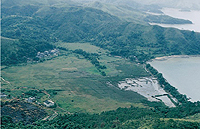 |